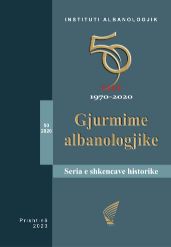KULTI I FLIJIMIT DHE KULTI I VARRIMIT NË NEOLIT ‐ ASPEKTE SHPIRTËRORE TË TRASHËGIMISË HUMANE
THE CULT OF SACRIFICE AND THE CULT OF BURIAL IN NEOLITHIC SPIRITUAL ASPECTS OF HUMAN HERITAGE
Author(s): Tomor KastratiSubject(s): Archaeology, Customs / Folklore, Ancient World
Published by: Instituti Albanologjik i Prishtinës
Keywords: cultural practices; religion; cult of sacrifice; cult fo burial; neolith; intangible heritage;
Summary/Abstract: Religious-based cultural practices important to the history of human spiritual identity are the cult of sacrifice and that of burial. Obedience to sacrifice as a way to achieve a higher goal has been trusted and manifested in various ways. In European culture, since ancient Greece, the symbolic destination of the altar is known in order to perform pagan cultural and social rites with themes for human deeds and goals, placing the human personality at the center of history and culture, which through heroism became it passed from the anthropomorphism of divine qualities to the deification of human characters, that is, from one form of idolatry to another. In a proverb, it is said: "Appearance is a door or a path that leads to hypocrisy." Sacrifice is a special form of liberation of the human soul. The true altar is connected with the heart, the place of obedience to the Worshiper, inevitably connected with the sincerity that appears, and confession fades to the point of loss this virtue, the shield of morality, the barrier to the corruption of the soul. Burial under the surface of the earth, the position of placing the body as in the form of a child in the womb of the mother before birth and with cutlery near the body, in addition to having a symbolic meaning, also presents aspects of outlook. Common characteristics of mother and earth are habitat, source of fruit, birth. Although, with death, body and soul are separated, the feeling of closeness and remembrance remains. Such a thing is evidenced by burial near houses, placing the body in the prenatal position, accompanying the body with funeral equipment; all of these are features of a procession, organization, meaning, and thought formed, of an original identity, which in essence give the meaning of continuity, connection, preservation, presence, return…
Journal: Gjurmime Albanologjike - Seria e shkencave historike
- Issue Year: 2020
- Issue No: 50
- Page Range: 53-58
- Page Count: 6
- Language: Albanian
- Content File-PDF

